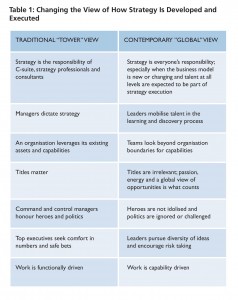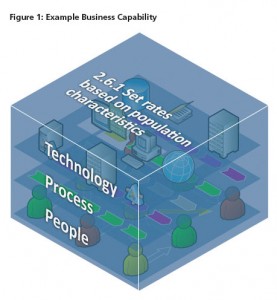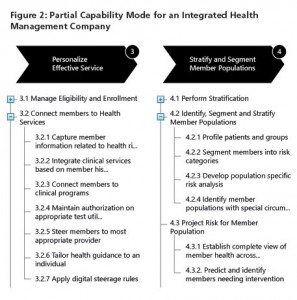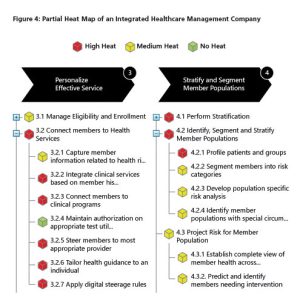By Richard Lynch, Amber Román And Derval Kennedy
In “Clarifying Strategy Is Simple. Aligning Your Organisation Is Not.” (The European Business Review, Sept/Oct 2014) the authors make the case that the clearest route to aligning and communicating strategy is through capabilities. That makes articulating and assessing capabilities a crucial new role for leaders.
Making capabilities explicit is the work of leadership. But it is not theirs alone.
As business models change and workforce demographics shift to younger workers, leaders not only need to define strategic intent, it is essential that they mobilise the organisation’s talent through capability development.
Companies such as Google,1 Facebook2 and Intercontinental Hotels Group3 challenge traditional views of how to develop strategy. They are disrupting conventional methods, as illustrated in Table 1.
If a well-written strategy does not ensure strategic action and results, what does?
The implementation of a formal, repeatable Strategy-to-Execution (S2E) framework does. This framework involves facilitating a cross-functional dialogue with a diverse group of talent to align the organisation on capabilities needed to deliver strategy and providing a clear roadmap to close capability gaps.
A capability-based, S2E framework provides:
• C-Level executives with clear guidelines for decision-making and investment choices throughout the organisation.
• Operating level executives with a clear set of capabilities that are necessary to execute the strategic game plan.
• Chief Financial Officers with a method for aligning investments and eliminating confusion and wasteful spending in the organisation.
• Annual operating plan and strategic planning teams with a rationale for what needs to be done.
• IT and other functional leaders with a focus for allocating resources to build enabling systems and support infrastructure.
• Leaders with a clear understanding of their role in strategy execution and a repeatable process to ingrain in the organisation.
• Leaders with a lens into the organisation’s culture and mindset readiness for strategic change.
• All employees with unambiguous priorities and a role in strategy execution.
In short, capabilities are the Rosetta Stone that make strategy understandable and approachable.
Capability Basics
The simplest definition of a business capability is What the organisation needs to do to execute its business strategy. Capabilities are containers of people, process and technology (see Figure 1). Capabilities, when stated in actionable terms, are the key to alignment and successful execution.
Capabilities exist across a value chain. Businesses govern a network of capabilities whether they own them or not: from raw material suppliers, to logistics, to third party distributors all the way to the end customer performing capabilities in a self-service mode.
Here are some examples of business capabilities:
• For a manufacturer looking to move into healthcare supplies, the ability to “combine elastic and non-elastic materials side by side”.
• For a university dealing with new demands from students, the ability to “provide real world experiences and interdisciplinary learning approach for students”.
• For the research company seeking to find the best talent, the ability to “offer multiple hiring options to bring on
talent globally”.
• For the healthcare insurer looking to improve outcomes and lower costs, the ability to “steer members to most appropriate Provider”.
• For a global vehicle leasing firm looking to determine future market offers and profit levels, the ability to “analyse vehicle leasing trends, margins and locations”.
Capabilities are sometimes confused with processes. Processes are the How’s or the tactical things about who does what, when, and where. Capabilities provide organisational clarity and focus for taking strategy to action.
Neither should capabilities be confused with competencies. Capabilities live at the organisational level, while competencies apply at the individual level. For example, an organisation that needs to be capable of “combining elastic and non-elastic materials side by side” needs employees who bring functional skills in materials engineering.
Since capabilities represent the organisation’s abilities that have potential for development or use, they are an expression of a future state, whether or not the organisation executes these capabilities today.
By developing and using capability models, leaders can help their organisations to be sustainable, competitive and profitable. Capability-based planning allows leaders to be ready for various future scenarios. It enables them to effectively “pivot” their business models as needed. As such, leaders need to ensure the longevity and success of their organisations first by fully understanding their capabilities, then developing the models to make strategy real and tangible to employees and customers.
Leader’s Role in Shaping Capabilities
The process of identifying capabilities is not a solitary exercise. Making them explicit, however, is the role of the leader. Most leaders, along with their senior teams, apply themselves diligently to the process of designing strategy, communication, organisation mission and vision. Some leaders may also excel at communicating strategic intent to down and across the organisation.
Few leaders ensure the successful execution of their strategies through capabilities. Here are four practical and powerful steps to ensure that success:
Step 1: Identify Capabilities
Companies that don’t express strategy in the form of capabilities often end up asking, “Why isn’t the strategy working?” Companies such as Pzifer, American Express, and Boeing4 are recognising that the capability model replaces organisational charts in discussions about execution. Capabilities can be canvassed though interviews, secondary research and field immersion.
While a list of capabilities is helpful, capability models are a clearer visualisation of strategic success (see Figure 2). Leaders can significantly improve organisation sustainability and agility by building out the core business and enabling models such as IT, and HR.
Where to start? Capability models are compelling and effective communication tools to engage, align, and motivate talent. Leaders at project, business unit or enterprise levels, should mobilise cross-functional resources to design capability models. Models should be holistic, end-to-end, and inclusive.
Leaders need to communicate the value and benefits of capability-based planning. The process of business modeling will highlight the capabilities that need to be explicit. Once identified, leaders need to “call out” and communicate the capabilities that the organisation “must have” in order to survive and succeed. This helps diffuse organisational politics and funding “the squeaky wheel”.
Tools such as the one illustrated in Figure 2 help overcome many business modeling obstacles, including:
• Artifacts becoming outdated.
• Business models not connected to other related models.
• No shared basis for initiatives or prioritisation.
• Guesswork driving development or maintenance of business or technology strategies and roadmaps.
Step 2: Assess a Capability’s Contribution to Strategy
Organisations seldom distinguish between capabilities that are necessary to run the business and those that transform or create distinction.
Capabilities contribute differently to accomplishing and delivering on strategy and should be nourished and sourced accordingly. The key to understanding this difference can set an organisation apart.
Some capabilities directly contribute to the organisation’s customer value proposition and have a high impact on organisation financials. It is critical to have a common understanding of why an organisation is valued by its customers. With this understanding, teams can then identify which capabilities deliver “Advantage” (shown in Figure 3).
Value contribution is assured when performance is among the best in peer organisations at an acceptable cost. Keep these capabilities within the organisation and protect the associated intellectual property. Moving to the top left quadrant, “Strategic Support” capabilities contribute through their direct support of Advantage capabilities and therefore have a high strategic value. Keep them close. For these capabilities the value contribution is assured when performed above industry equivalent at a competitive cost.
Moving to the lower right quadrant, these capabilities are “Essential”. They may not be visible to the customer but have a big impact on the bottom line. Focus here is on efficiency improvements; especially in high volume work. Value contribution is assured when performance is at industry equivalent below competitors’ cost. Other capabilities are “Business Necessity”. Value contribution is assured when performed at industry equivalent effectiveness and low cost. If not efficient, they are candidates for alternate sourcing.
Capability Value Contribution is not the same as traditional value add analysis since there is value-added work and non-value-added work in Advantage, Strategic Support, Essential, and Business Necessity capabilities. Determining the value contribution helps focus resources and sourcing alternatives on capabilities that create value and distinctiveness, or identifies where to target efficiency work, either through rigorous process improvement or sourcing to a low cost provider.
A leader’s role in rating the capabilities’ value contribution is a focal point in engaging the rest of the organisation. Leaders can contribute to this process in many ways:
• Frame the assessment in terms of the strategy in an approachable manner. Tell stories and show examples of scenarios that describe this future state vision. Make the future vision real for the organisation to facilitate the assessment of strategic contribution.
• Pressure-test the strategic contribution with constituents throughout the organisation. Help to slowly move their mindsets to the future state through their own assessment of the capabilities’ contribution to this future state.
• Engage the organisation in defining why a capability does or does not contribute to the strategy or have a financial impact. Elicit views of different constituents in the organisation to get a well-rounded perspective.
Step 3: Assess Capability Performance
The next step for a leader and the team is to understand how well the organisation is performing these capabilities and where capability gaps exist.
Performance gaps are based on two performance dimensions: effectiveness and efficiency. The question to ask is, “Given our strategy, what work needs to be executed at world class levels, and what work can be performed at industry equivalents?” For example, the HR Director of a fuel cell company observed that the organisation excelled at metal container technology, but fell short on the more strategic plastic container applications that were critical for new mobile solutions. The ability to “apply plastics container technologies” was an advantage capability. Being average was not acceptable. This finding led to immediate, innovative ways to attract and recruit new talent to the company.
An easily understood tool, called a Heat Map, can be used to communicate an organisation’s capability gaps. Heat maps indicate the level of attention required to address the gap. The heat index is calculated using performance measures along with the value contribution. High heat, illustrated as red, suggests required investment (see Figure 4).
The process of assessing performance allows leaders to engage talent at many levels in the organisation. In some of the best teams, titles are left at the door and a senior executive is no different than the line employee when contributing to this process.
This is not trivial work. Leaders can contribute directly to this process by:
• Engaging the organisation’s employees in this team activity and aligning key organisational motivators to help encourage engagement.
• Multiplying the value derived from critical initiatives by:
i. Targeting cost reduction without compromising strategy execution or quality
ii. Preserving capabilities required for long-term success
iii. Aligning thinking about investment prioritisation
iv. Getting more value from technology
• Applying the entire team’s fingerprints all over the model.
When leaders get deeply involved in developing and pressure testing the model, it’s far more likely that it will endure as a basis for continuous alignment, structured learning, better sourcing, and accelerated improvement.
Step 4: Focus on the Most Urgent Gaps
When leaders do not assess the strategic value or performance of a capability, organisations experience dysfunction, such as resource contention, stalled execution, and incoherent project agendas. Does this happen in your organisation?
By focusing on the most urgent gaps these symptoms can be alleviated.
For example, the COO of a US university saw that Human Resources lacked the capability to attract top research talent. Yet, in other parts of the university they not only had this capability, they excelled at it. This capability directly contributed to the university’s strategy and needed to be at world-class levels across all sites.
Having determined if the organisation needs to invest in a capability, the next step for a leader is to evaluate the level of maturity the capability needs to perform and when the capability needs to be realised. Some capabilities need immediate improvement while others can be matured over many years; in fact, there may be value in waiting. For example, a company moving into medical products needed to conduct clinical trials immediately, but could not set these up in the critical timeframe. Competitive forces were such that they could not wait for this capability to become a mature internally. The best option was to outsource these capabilities to accelerate speed to market and gauge market reaction.
A leader’s role in addressing the most urgent gaps is to make these steps explicit, to communicate the process to drive alignment, and seek commitment from the rest of the organisation. Experienced leaders must use their wisdom and invite a broad range of constituents into the root cause analysis of the capability gap. Involving the organisation in this analysis is an important step in evaluating whether to close the gap through brokering, borrowing, building or buying the capability.
What this Means for Today’s and Tomorrow’s Leaders
As hierarchical organisations become flatter and leaner, new leaders are easier to spot. They are the individuals, regardless of title or age, that:
1. Stumble forward: Immerse themselves in the organisation’s ecosystem, and look and listen for capabilities that will carry your business forward, future scenarios notwithstanding.
2. Connect and mobilise: Engage resources in the ecosystem to help identify future state capabilities.
3. Embrace differences: Are intellectually curious and constructively dissatisfied with the status quo.
4. Develop capability models: Know when to stay out of the “people, process, and technology” weeds.
5. Document capability gaps: Leaders are expected to resolve “good enough”, excess, and shortfall.
6. Establish an investment agenda: Focus and sequence capability building, then execute it with conviction.
7. Question priorities: Challenge or reject projects that are not aligned to strategic intent.
About the Authors
 Richard Lynch is a Vice President at Accelare, Inc., creators of WorkFit, a collaborative, enterprise tool for taking strategy to execution (www.accelare.com). He is author of The Capable Company (Wiley-Blackwell, 2003).
Richard Lynch is a Vice President at Accelare, Inc., creators of WorkFit, a collaborative, enterprise tool for taking strategy to execution (www.accelare.com). He is author of The Capable Company (Wiley-Blackwell, 2003).
 Amber Román is a Principal in Accelare’s Strategy to Execution practice, with a focus on enterprise architecture and organisational impacts.
Amber Román is a Principal in Accelare’s Strategy to Execution practice, with a focus on enterprise architecture and organisational impacts.
 Derval Kennedy is a Principal at Archtexx, a European Business Architecture consulting firm, headquartered in Frankfurt, advising global leaders on innovative, sustainable strategies. She runs the Ireland/UK practice.
Derval Kennedy is a Principal at Archtexx, a European Business Architecture consulting firm, headquartered in Frankfurt, advising global leaders on innovative, sustainable strategies. She runs the Ireland/UK practice.
The authors are soon to publish Strategy Made Simple (as well as inspiring and real).
References
1. Google’s weekly, no-holds-barred, all-hands meeting requires the courage of its entire senior team. It’s a brave thing for the founders to offer transparency to their team. But this marriage of people and strategy makes Google one of the most sought-after — and valuable — employers on the planet. Read more: http://www.businessinsidercom/involving-employees-in-strategising-2013-6#ixzz3FHb6eglc
2. CEO Mark Zuckerberg said “The biggest risk is not taking any risk… In a world that changing really quickly, the only strategy that is guaranteed to fail is not taking risks.”
3. IHG involved 100s of employees is the strategic demerger from its parent company Six Continents plc in 2003, earning an ASTD award for managing change. They continue to involve talent, winning the ASTD BEST Awards for organisations that demonstrate enterprise-wide success through employee learning and development.
4. Members of the Accelare Business Architecture Roundtable.








































